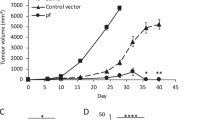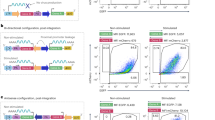Abstract
Tumor cells, such as lymphoma cells, are possible targets for gene therapy. In general, gene therapeutic approaches require efficient gene transfer to host cells and sufficient transgene expression. However, lymphoma cells previously have been demonstrated to be resistant to most of the currently available gene transfer methods. The aim of this study was to analyze various methods for transfection of lymphoma cells and to improve the efficiency of gene delivery. In accordance with previously published reports, lymphoma cells were demonstrated to be resistant to lipofection and electroporation. In contrast, we present an improved adenoviral protocol leading to highly efficient gene transfer to lymphoma cell lines derived from B cells as well as primary lymphoma cells being achieved with an adenoviral vector system encoding the β-galactosidase protein. At a multiplicity of infection of 200, up to 100% of Daudi cells and Raji cells and 70% of OCI-Ly8-LAM53 cells could be transfected. Even at high adenoviral concentrations, no marked toxicity was observed, and the growth characteristics of the lymphoma cell lines were not impaired. The transfection rates in primary cells derived from six patients with non-Hodgkin’s lymphoma were 30–65%, respectively. Transfection efficiency could be further increased by addition of cationic liposomes to adenoviral gene transfer. Furthermore, we examined the expression of the Coxsackie-adenoviral receptor (CAR) and the integrin receptors on the lymphoma cell surface. Flow cytometric analysis showed that 88% of Daudi cells, 69% of Raji cells, and 6% of OCI-Ly8-LAM53 cells expressed CAR on the cell surface. According to our data, adenoviral infection of lymphoma cells seems to be mediated by CAR. In contrast, integrin receptors are unlikely to play a major role, because lymphoma cells were negative for αvβ3-integrins and negative for αvβ5-integrins. In conclusion, this study demonstrates that B-lymphoma cell lines and primary lymphoma cells can be efficiently transfected using an adenoviral vector system. By adding cationic liposomes, the efficiency of adenoviral gene transfer to primary tumor cells could be further improved. This protocol may have an impact on the use of lymphoma cells in cancer gene therapy.
This is a preview of subscription content, access via your institution
Access options
Subscribe to this journal
Receive 12 print issues and online access
$259.00 per year
only $21.58 per issue
Buy this article
- Purchase on Springer Link
- Instant access to full article PDF
Prices may be subject to local taxes which are calculated during checkout
Similar content being viewed by others
Author information
Authors and Affiliations
Rights and permissions
About this article
Cite this article
Buttgereit, P., Weineck, S., Röpke, G. et al. Efficient gene transfer into lymphoma cells using adenoviral vectors combined with lipofection. Cancer Gene Ther 7, 1145–1155 (2000). https://doi.org/10.1038/sj.cgt.7700209
Received:
Accepted:
Published:
Issue Date:
DOI: https://doi.org/10.1038/sj.cgt.7700209
Keywords
This article is cited by
-
High-throughput continuous-flow microfluidic electroporation of mRNA into primary human T cells for applications in cellular therapy manufacturing
Scientific Reports (2020)
-
Induction of cell size vesicles from human lymphoma cell lines and their application to drug carriers
Cytotechnology (2010)
-
Apoptosis Induction in Human Lymphoma and Leukemia Cell Lines by Transfection via Dendrosomes Carrying Wild-Type p53 cDNA
Biotechnology Letters (2006)
-
Suicide gene therapy: conversion of ethanol to acetaldehyde mediated by human beta 2 alcohol dehydrogenase
Cancer Gene Therapy (2004)
-
Effects ofin vivo gene transduction of anti-MDR1 ribozyme in combination with chemotherapy on multidrug-resistant human lymphoma growth in mice
Chinese Journal of Cancer Research (2003)



